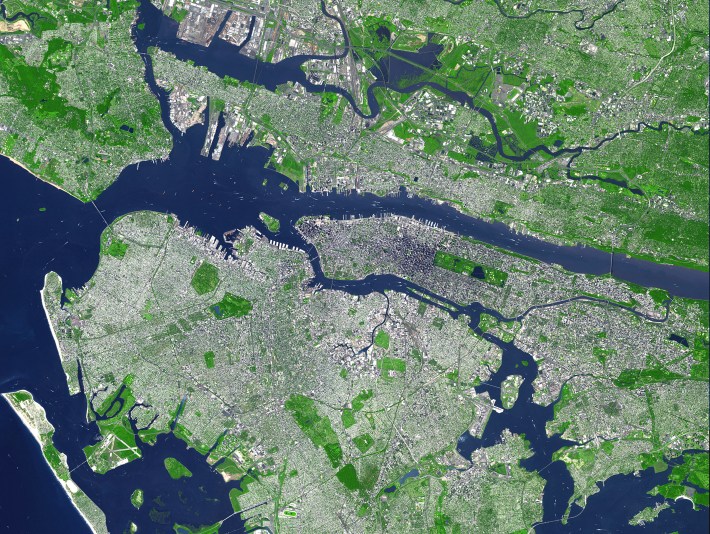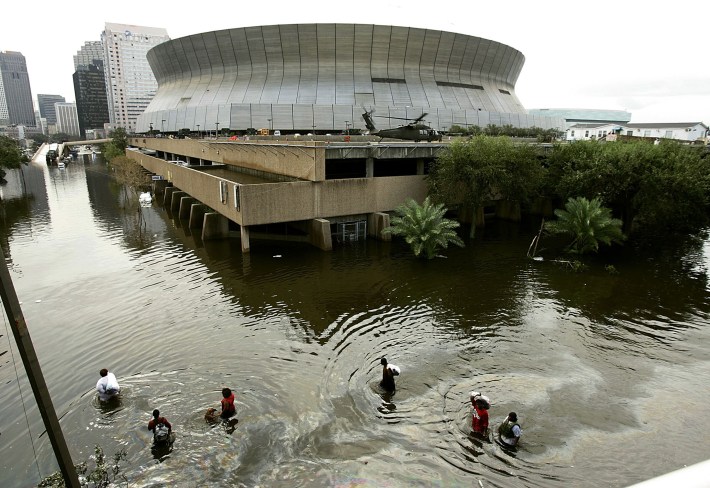Future generations, if there are any future generations, may one day look back at the Texas Rangers’ stadium as the first stadium designed for the Anthropocene epoch. Globe Life Field was built at a cost of $1.2 billion, nearly half of which was provided by Arlington taxpayers, because the team’s not-that-old stadium lacked air conditioning. While the new ballpark was unfavorably compared to the Chernobyl sarcophagus upon its completion last year, it reflects the demand for ever-more-sumptuous conditions for attendees of sporting events even while the world outside becomes ever less livable.
Last week’s historic freeze aside—and contrary to the opinion of certain idiot senators, even in a warming climate we’ll still have snow, and perhaps even more of it—Texas has always been hot, and has only gotten hotter in recent years, along with the rest of the planet. But what’s around the corner thanks to 70 years of soaring fossil fuel emissions is not your grandfather’s “hot.” By the 2040s, according to one projection, the average Dallas temperature is expected to be 94 degrees, eight degrees higher than at the turn of the century. The hottest days are expected to reach a staggering 120 degrees, a temperature at which any humidity over 30 percent would result in a “wet-bulb” temperature of more than 160 degrees, the limit for human survivability. It would be literally deadly to attend a ballgame outside.
The Rangers are just one of many pro sports teams that should be worrying about the future climate. The Oakland A’s are about to move to waterfront property that could in a few decades be part of San Francisco Bay. Miami has five pro sports teams and an average elevation of 6.5 feet above the Atlantic Ocean, which is currently rising by four inches per decade, and accelerating. Phoenix and Las Vegas are in the midst of a climate-fed megadrought that is one of the worst in the last 1,200 years.
At some point, whether it’s 10, 20, or 100 years from now, some of these cities are all but certain to tip over from “unlivable” to “no, really, unlivable.” Which will be the first to go over the edge, with residents fleeing flooded basements or broiling heat for higher elevations and cooler latitudes? No one can say for sure, partly because climate predictions are an inexact science, and specific weather events are impossible to forecast: If Hurricane Katrina had zigged instead of zagged, the New Orleans metro area might still have another 100,000 residents. We also have no idea how well or whether humanity will be able to stop burning fossil fuels like there’s literally no tomorrow—though thanks to the magic of climate lag, much of the planet’s future warming is already baked into the carbon we’ve previously injected into the air and oceans.
That doesn’t mean, though, that we can’t make educated guesses, if only to determine which teams’ gear to stock up on as future collectors’ items. With the help of climate studies and a pair of academics specializing in “climate migration”—i.e., determining which populations will be driven from their homes—let’s look at some of the cities where it’s most likely a warming climate will change the sports landscape. And, oh yeah, the entirety of our lives, too.
Florida: America’s next Atlantis
With 11 major-league teams including MLS, Florida has more franchises than any other state other but California. It may not remain that way for long.
The biggest problem with Florida land is that it’s barely land at all. A limestone shelf that only first emerged from the sea 10 to 20 million years ago (a relative eyeblink in geological time), it never emerged far: The highest point in Florida is just 345 feet above sea level, and most of the state is far lower than that. Play around with NOAA’s sea level rise mapper, and it doesn’t take long before much of Florida is submerged beneath the waves.
“Long” for sea-level rise is measured in decades, but Miami will face other concerns in the meantime. Long before the city is actually underwater, it could run out of drinking water thanks to rising sea levels swamping its freshwater aquifer. And as one remarkable Bloomberg article put it, “Then there’s the feces”—liquid from septic tanks that has leaked into the soil and could soon contaminate the rising water table.
“Miami-Dade and Broward counties and the Florida Keys, it’s really hard for me to see the light at the end of the tunnel for them in the very long run, like 100 years,” says Mathew Hauer, a sociologist at Florida State University who studies the demographic impacts of climate change. Even in the short run, he notes, Miami is regularly seeing extreme high tides that are creating traffic snarls for commuters, and those will only get worse.
“In Miami you’re looking at within the life of a mortgage for seeing significant impacts,” says Hauer. “It’s already affecting housing prices in Miami. So it’s not some sort of esoteric, far-off threat.”
St. Petersburg has even more land within five feet of sea level than Miami—32 percent vs. 20 percent—which could be bad news for the Rays if they remain in town for much longer. Orlando is inland (as much as anything in Florida is inland), and so will likely see more problems from rising temperatures, says Hauer. And while Jacksonville is at a somewhat higher elevation, that’s not the case for the Jaguars’ stadium, which sits right alongside the St. Johns River, which is “extraordinarily vulnerable” to sea level rise, says Jesse Keenan, a Tulane University real estate professor who has widely consulted on climate adaptation. “The stadium complex is built right on the river right there—and that’s not good.”
This is the front parking lot at First Coast News right across from Everbank Field. #FCNStorm #HurricaneIrma pic.twitter.com/nsGGMA2aKT
— Heather Crawford (@HeatherFCN) September 11, 2017
Arizona: Once and future desert
Sometime in the 13th century, the Anasazi people of what would later become known as the Four Corners area (where Arizona, New Mexico, Colorado, and Utah meet) picked up after nearly three millennia and headed south, some of them as far as what is today Mexico. The likely culprit was a shift in the local climate that led to sustained drought, bringing about intertribal warfare, “goon squads” carrying out mass executions, and even cannibalism.
The American Southwest eventually became habitable again, but that may be only temporary. Arizona is already 25 years into a megadrought, and climate change isn’t going to help end it anytime soon: A warming world is expected to further reduce rainfall in the state, and also reduce snowfall to the north, meaning less snowpack and less water to flow through the Colorado and other rivers come spring.
At first glance, this might seem less existential crisis than perpetual annoyance. Even Hauer expects that sea-level rise will lead to more mass migrations than heat, if only because you can’t just crank the A/C to deal with a flooded house. “People live in Iran and stuff!” he observes. “It’s hot! But no one lives underwater.”
But there’s hot and then there’s hot. A recent study by ProPublica and the Rhodium Group projected that within 20 to 40 years, some counties in Arizona could be above 95 degrees for half the year. Six counties—Pinal, Graham, Cochise, Mohave, Yuma, and Maricopa—are considered at high risk of becoming “uninhabitable” for humans within that time span. Maricopa County just happens to be home to the Arizona Cardinals, Diamondbacks, and Coyotes, and the Phoenix Suns. And while all those teams play in stadiums with roofs and air conditioning, that won’t help much if their fans have all fled to cooler climes.
As a Sierra Club article asked in 2019, “What happens if there's a sustained power outage during a heat wave, leaving the city without air conditioning for days at a time? What happens if the drought continues for 50 or 100 years? What happens during a major recession when thousands of people suddenly can't pay their power bills?”
The first time it happens, probably nothing. The second or the third, people may start to pick up and move, at which point the Coyotes will have an even tougher time than usual selling tickets.
New York: Revenge of the harbor

If Miami is number one among U.S. cities likely to be swamped by a swelling Atlantic Ocean, New York is a solid second. (Boston has a shot at a play-in game.) Settled amid a tangle of tidal estuaries by Europeans seeking a convenient harbor, the city is now stuck with seawater around and amidst the five boroughs.
The Yankees, Rangers, Knicks, and Nets all play at relatively high elevations—the former three play atop the bones of ancient mountains, and Brooklyn’s arena is on a giant mound of glacial dirt better known as Long Island—and should be safe from sea level rise, at least until all of Greenland’s glaciers melt, which could take millennia but is at this point already a near-certainty. The Mets’ Citi Field, though, is on a former wetland (after an interim stop as the ash heaps memorialized in The Great Gatsby), and the Giants and Jets famously play in a New Jersey swamp. At 10 feet and seven feet above sea level, respectively—points we will likely hit no later than early next century—both stadiums would be among the first to be submerged by rising seas. Hauer notes that climate scientists distinguish between two kinds of migration-spawning disasters: “press events” that slowly ramp up the pressure through gradually worse and worse conditions, and “pulse events,” like a single hurricane or heat wave, that cause people to relocate en masse. “The slow, gradual changes are a bit easier to predict than the really rapid ones,” he says.
The really rapid ones, though, are what are most likely to do in New York. The city’s biggest fear would have to be a repeat of Superstorm Sandy, which but for a few quick-thinking transit workers could have left the city’s transit system completely wrecked. As it was, many subway lines were unusable for months afterwards, and authorities have been busy ever since trying to plug every one of thousands of subway entrances, vents, manholes, and other potential entry points for floodwaters, to prevent a repeat. The most comprehensive solution, a massive storm-surge barrier to be erected just offshore, would cost an estimated $119 billion and could be obsolete thanks to rising sea levels before it’s even finished. While it may be hard to picture New York completely emptying out, it’s likely to be smaller and poorer once you can’t ride in a hole in the ground because the ground is entirely saturated.
Las Vegas: Boom to bust?
Hardly any U.S. cities are growing at anywhere near the pace of Las Vegas: The city proper now has two-and-a-half times the population it had in 1990, and remains the second-fastest growing city in the nation (after Greenville, N.C.). It’s a pace that has helped it land on the national sports map, with the Golden Knights and Raiders both landing in town since 2017, and constant murmurs that it could be a contender for MLB, NBA, and MLS teams.
Like much of Arizona, Las Vegas gets its water from the Colorado River, a once-mighty torrent that has lost so much water to dwindling snowpack and diversion for irrigation that it no longer reaches the ocean. Even as the population of Nevada has soared, a 2019 study has forecast that by the middle of the century (2036 to 2065), Las Vegas will see the number of days where the heat index exceeds 105 degrees jump from three a year to 31. And by the last three decades of the century, there could be two solid months of that level of extreme heat.
In fact, Vegas’s success could contribute to its eventual downfall: A 2019 Guardian report observed that as the city grew, “hundreds of miles of desert landscape were paved over with heat-absorbing asphalt and concrete, worsening a ‘heat island’ effect in the cauldron-like valley.” In that same article, a former state senator speculated that the city could become “a place where we just go from our houses to our cars to our offices, and never go outside because it’s too hot.” Once all those air conditioners running at once lead to regular blackouts, though, it’s not hard to see tourists thinking it’s safer to vacation somewhere more temperate, like Newfoundland.
San Francisco: Beware the bay
If there’s a surprise on this list, it’s likely the San Francisco bay area, which is too far north to get the worst of heat and drought, and too hilly to be submerged, even if it is sinking under its own weight. But that’s only true of San Francisco proper: Much of the East and South Bay, along with the densely populated portions of the Peninsula and Marin County, is at low elevations. And then there’s the problem of the bay itself.
“The city itself, it’s known for its hills, so it’s not nearly as affected,” says Hauer. “But the Bay Area itself is probably the most threatened area in California in terms of sea level rise.”
Keenan explains that because the San Francisco Bay is so shallow—a former valley that was flooded by rising seas after the last Ice Age, the bay averages only 14 feet deep—“a small amount of sea level rise actually amplifies the bay sea level rise.” Plus, he says, the surrounding hills actually exacerbate flooding from rainfall, which quickly pours down the slopes and into the shallow bay: “There was an extreme rain event a couple of years ago where the entire elevation of the bay rose by two feet.”
This could be a bit of a problem for sports, given that the Warriors and Giants both play in bayfront venues in San Francisco, while the Athletics’ owners are plotting to open a new stadium across the water at Oakland’s Howard Terminal. (The San Jose Sharks and San Francisco 49ers are on somewhat higher ground.) A’s execs say they plan to raise the stadium’s foundation by four feet to put it 10 feet above sea level, but that won’t help much if fans have to wade through waist-deep water to get to the turnstiles.
Or if fans up and leave entirely. A 2017 study by Hauer predicted that 700,000 people could end up leaving the Bay Area by the end of the century. That would be enough of a shift to drop the metro region to the size of Seattle—and probably well below it, if many of those fleeing northern California head for Washington state. Or, you know, maybe not Seattle. Spokane?
New Orleans: The surge always wins

I mean, just look at this map of what will become of New Orleans if sea level rises even by five feet. You tell me that’s a viable place for NFL and NBA teams.
When the New York Times first ran that chart in 2012, it projected we could see five feet of sea level rise within 100 to 300 years; now some predictions say we could hit that level before the end of the century. If so, it will leave New Orleans little more than a pair of narrow channels venturing out into the Atlantic, much like the Mississippi River’s current mouth already looks today.
Really, it’s incredible that New Orleans still exists at all. Built on a sedimentary delta that is continually sinking into the Gulf of Mexico, alongside a river that for decades has been fighting the Army Corps of Engineers’ best efforts to keep it from shifting course to a completely different part of the state, New Orleans by all rights should be gone already. And it almost was: After Hurricane Katrina—probably the biggest climate-change pulse event we’ve seen—much of the population scattered across the country, many never to return.
New Orleans has almost returned to its pre-Katrina population, in part thanks to federal aid programs that encouraged rebuilding and drew in construction workers and others to live in the rebuilt homes, but many longtime residents never came back in part thanks to federal aid programs that gave out less money to those whose homes had been worth less to begin with. The next storm might not do the city in, but the one after that might. And because warmer oceans spawn more powerful hurricanes, every year the odds go up of a surge event after which New Orleans is no longer considered too big to fail.
So, where to next?
One of the problems for writers about climate change is that it’s an impossible balancing act. Draw too fatalistic a picture and people will throw up their hands and give up; tell them that there’s still time to act, and they’ll hold out to buy one last gasoline-powered car. Plus, we know enough now to justify at least some fatalism. As much as we (by which “we” means mostly fossil fuel companies, fossil fuel regulators, and the people who elect them) hold the fate of the world in our hands, it’s still a choice between the unthinkable and the merely horrific. One recent study says that we’ve already pumped enough carbon into the air to warm the Earth by 2.3 degrees Celsius, which is already plenty to create a nightmare world of flooded coastlines and killer heat waves.
So let’s just say this: At some point, probably this century and maybe much sooner, the United States will find its residents migrating to cooler climes and higher ground. (We’re not even getting into where more than 100 million climate refugees from Latin America, sub-Saharan Africa, and Southeast Asia will end up, which could utterly remake the demographics of numerous U.S. cities.) And much of it will likely be the result of unpredictable pulse events: Which city becomes the first to be wiped off the map—or at least reduced to sub-major-league size—could be up to whether some future cold front sneaks a few miles further south or north, putting a different city in a hurricane’s crosshairs.
The question then becomes less where people will move from, and where they’ll move to. “After Hurricane Katrina, people from New Orleans ended up in Albany, N.Y., and Syracuse, N.Y., and Minnesota,” says Hauer. “The storm literally blew them all over the country. [But] the vast majority of people who relocated after Hurricane Katrina ended up in Atlanta, ended up in Dallas, ended up in Houston. The same thing will happen, I imagine, with a climate effect.”
Both Hauer and Keenan note that many northern cities not only will develop more pleasant climates in coming decades, but they conveniently have excess capacity, having been built out for larger populations that moved on as heavy industry died and the Rust Belt took hold. So if a New Orleans or Miami is eventually wiped off a map, maybe it will end up replaced by a Syracuse or Duluth.
“People are over time moving north, and I think they are going largely to the midwest, certainly around the Great Lakes,” Keenan says. “And sports teams are going to follow where the people go. So, will the Lakers ever play in Minnesota again? They’re going to have enough water.”






